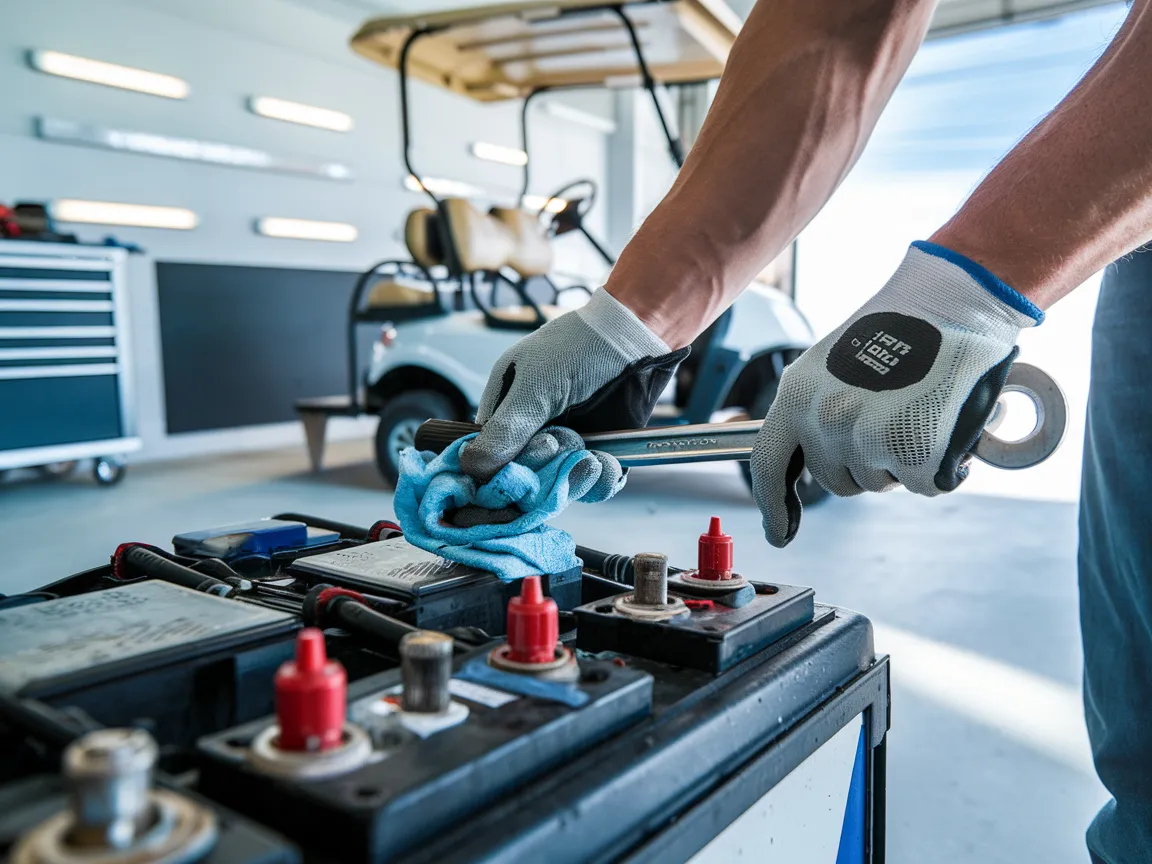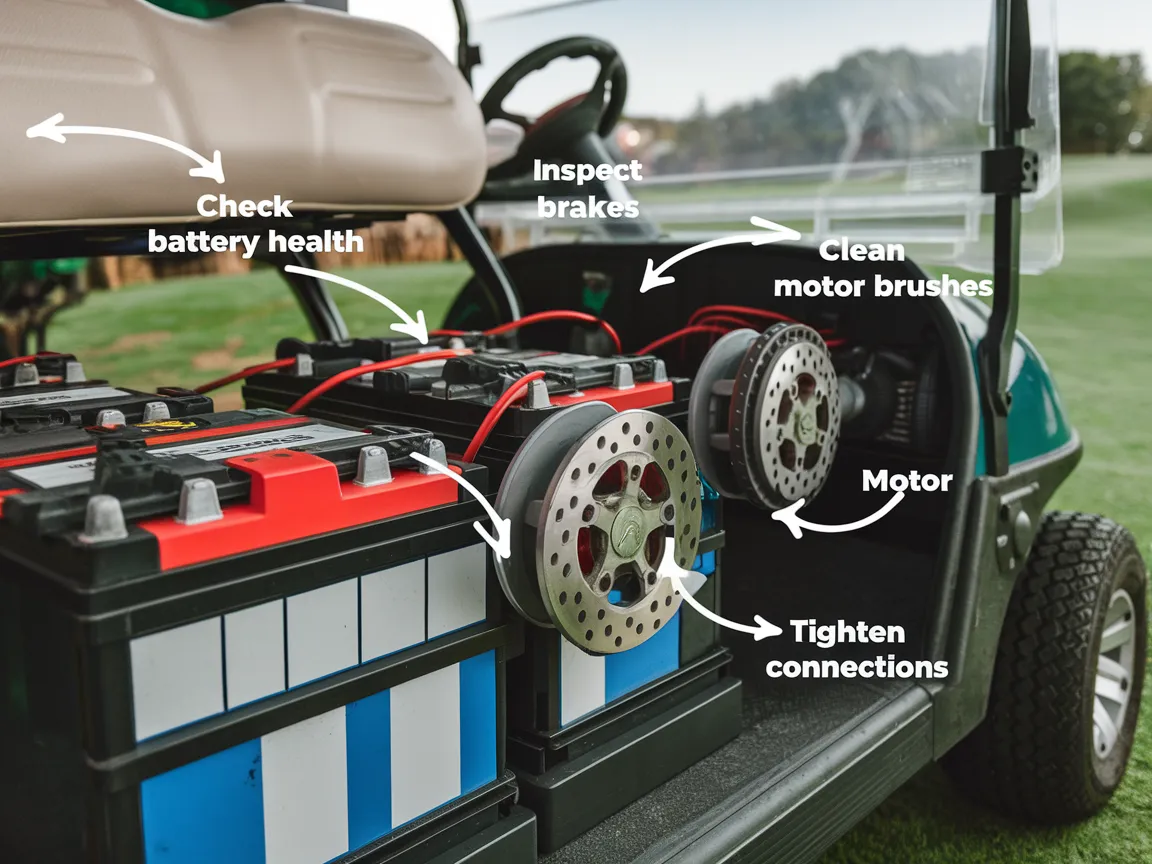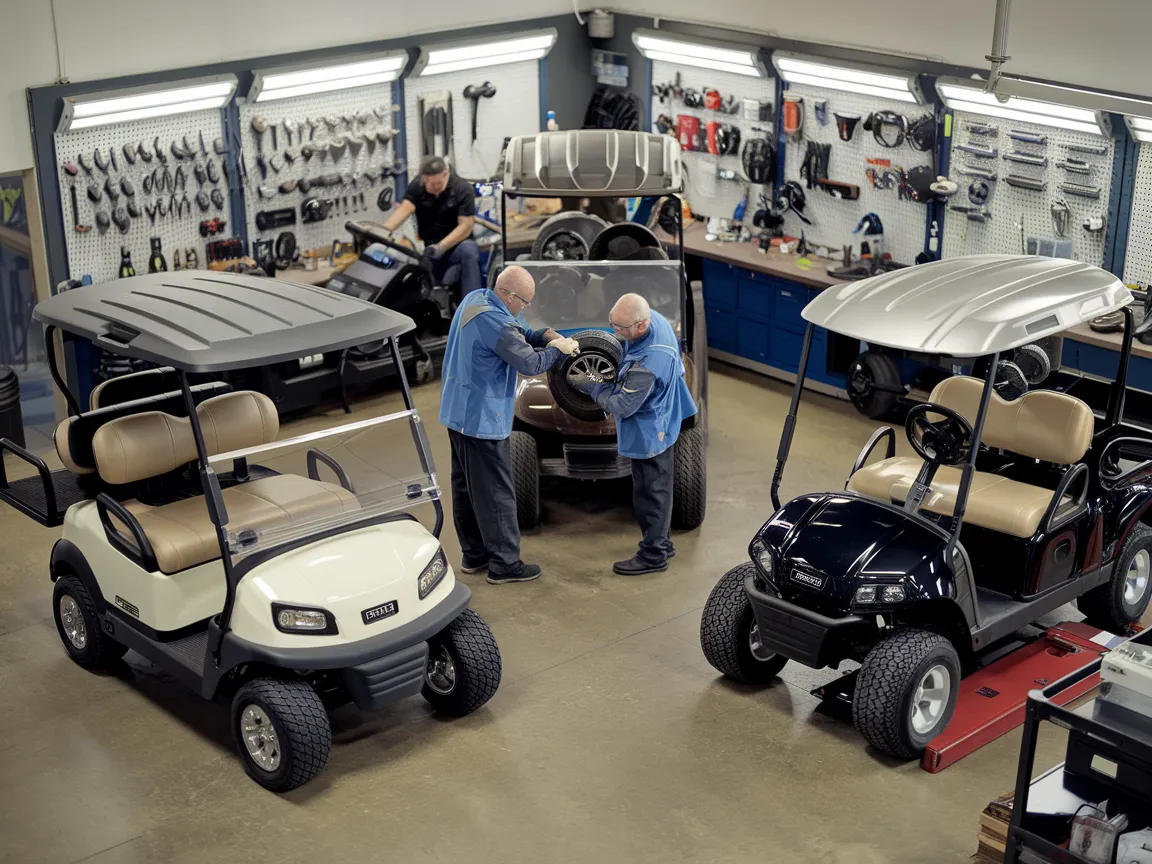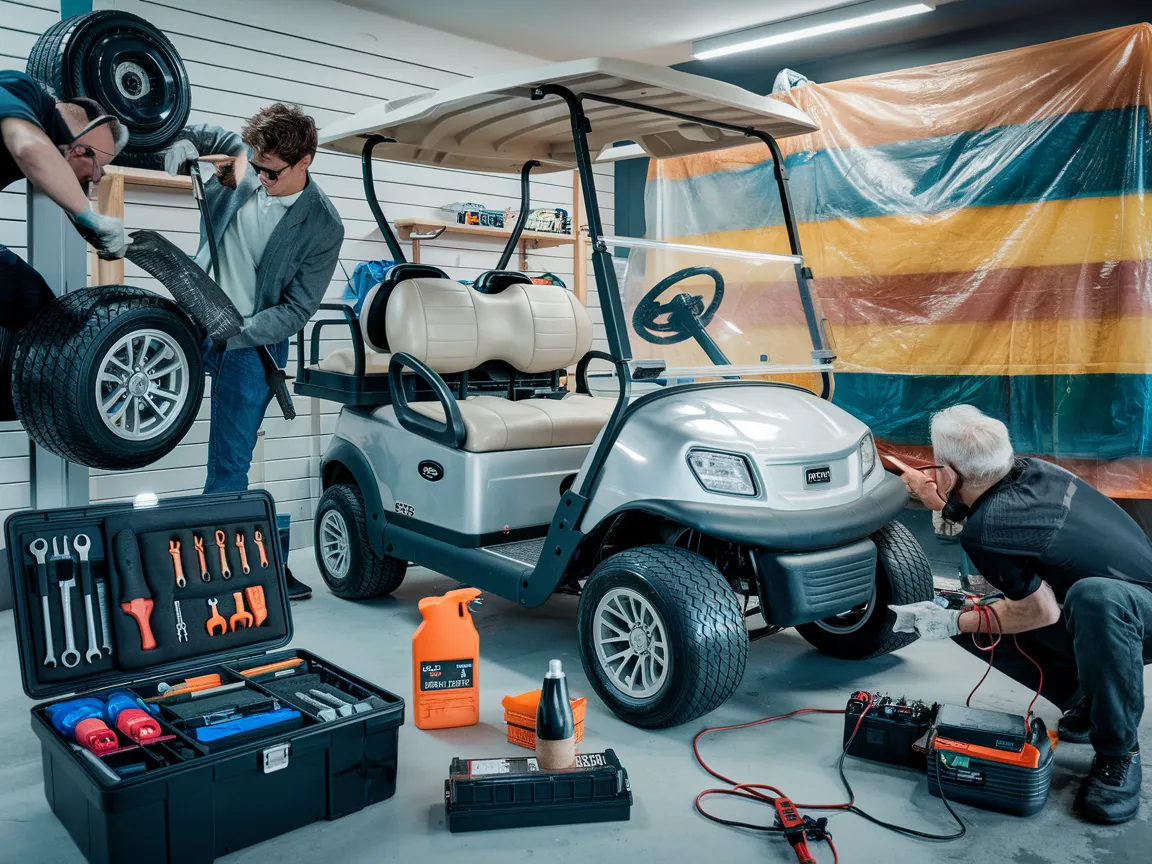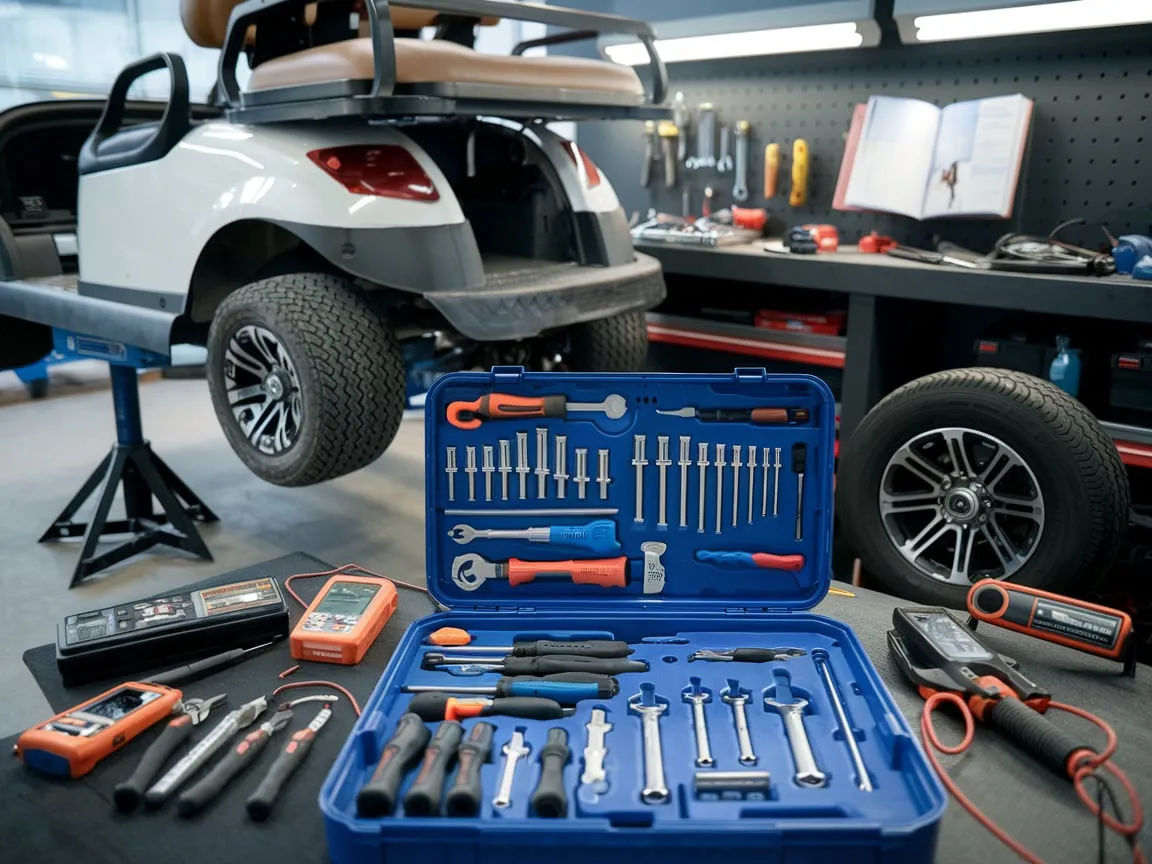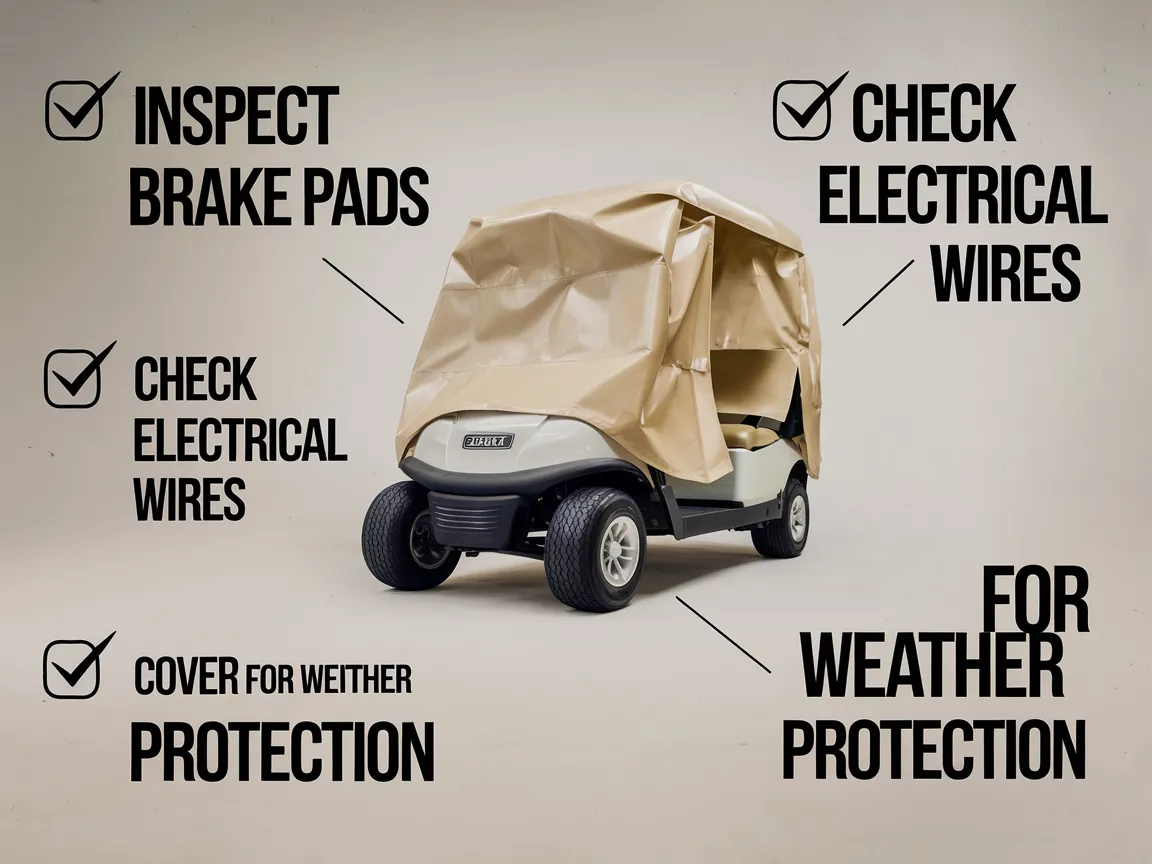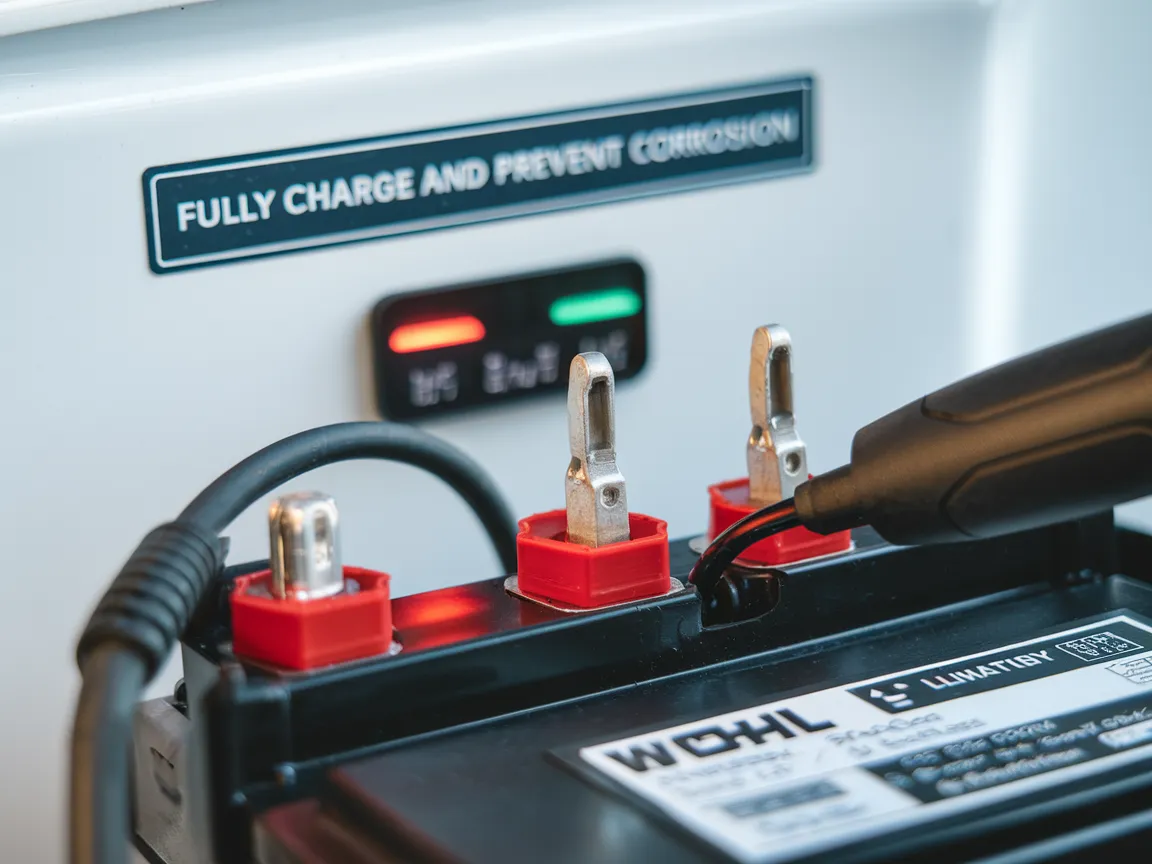Essential Golf Cart Repair Tips for Smoother Rides
Golf cart repair is essential for maintaining electric, gas, and solar models. Choose experienced technicians for brands like E-Z-Go and Yamaha, prioritize safety checks, and ensure regular maintenance to extend lifespan.
Use quality parts and services to stay compliant with regulations and keep your golf cart operating smoothly in community-friendly environments.
What Is The Proper Maintenance Of A Golf Cart
The key to avoiding golf cart issues is sticking to a simple maintenance routine that prevents breakdowns and costly repairs.
Start with your battery care. Clean the terminals regularly, check water levels if applicable, and always charge after use to avoid sudden power loss.
Listen for squeaks and tighten loose pads or bolts for brakes to ensure safe stops.
Don’t overlook tires. Keep the pressure at the recommended PSI and inspect for wear to avoid poor handling.
Here’s a quick reference table to guide your routine:
| Maintenance Task | Frequency | What to Check |
|---|---|---|
| Battery Care | Weekly | Terminals, water levels, charging routine |
| Brake Inspection | Monthly | Pad alignment, bolts, and squeaks |
| Tire Check | Bi-weekly | Pressure, tread, and wear |
| Electrical System | Monthly | Connections, wiring, and corrosion |
| Full Wash & Clean | Monthly | Body, undercarriage, and motor area |
Sticking to these simple steps will prevent common golf cart problems like power failures, brake issues, and uneven rides.
How Regular Maintenance Boosts Your Golf Cart
Regular maintenance keeps your golf cart reliable, saves money, and avoids sudden breakdowns.
A clean battery with secure terminals prevents power loss, while properly adjusted brakes ensure smooth and safe stops. Keeping tires inflated improves traction and stops uneven rides.
Quick checks of the electrical system catch loose wires or corrosion before they cause starting issues.
Even a simple wash removes dirt that can damage the motor and undercarriage.
Common Golf Cart Problems and How to Fix Them
Corroded terminals or low battery water levels cause power loss and stalling. Loose connections, blown fuses, or a faulty solenoid lead to no power.
Debris buildup or worn motor brushes result in motor stalls or overheating. Squeaky brakes or weak stopping power indicate worn brake pads or dirty components.
What Is The Most Common Problem With Electric Golf Carts
Electric golf carts are a staple on the course, offering convenience and efficiency for players of all levels.
Among the various issues that can arise, battery failure stands out as the most common problem.
Battery Issues: The Most Common Problem for Golf Carts Owners
Battery problems are the number one headache for electric golf cart owners. Here’s why they fail and how to address them:
Charging Problems:
Improper charging is a leading cause of battery failure. Undercharging leads to sulfation, where sulfate crystals build up on the battery plates, reducing efficiency.Replacement Needs:
Golf cart batteries typically last between 4 to 6 years depending on usage and maintenance.Water Levels:
Flooded lead-acid batteries require regular maintenance. If the water levels drop too low, the plates can become exposed, leading to irreversible damage.Corroded Connections:
Corrosion on battery terminals can impede the flow of electricity, causing poor performance or complete failure.
Electrical Problems: Beyond the Battery
While battery issues are the most frequent, electric golf carts can also face other electrical problems:
Wiring Malfunctions:
Loose or corroded wiring can cause electrical failures. Inspect the wiring harness regularly and repair or replace damaged wires promptly.Controller Issues:
The controller regulates power from the batteries to the motor.
Mechanical Issues Of Golf Carts: Brakes and Steering
Mechanical problems can also plague electric golf carts, affecting safety and performance:
Brake Failure:
Worn brake pads or damaged brake cables can lead to brake failure, making your cart unsafe to drive.Steering Problems:
Loose or worn steering components can make your cart difficult to control.
How Long Should Tires Last on a Golf Cart
Over time, the wear and tear on your golf cart can lead to performance issues:
How often should you change golf cart tires:
Worn tires can affect traction and stability. Check tire pressure and tread depth regularly, and replace tires when they show signs of excessive wear.Suspension and Axle Maintenance of Golf Carts:
A worn suspension or damaged axle can lead to a rough ride and poor handling.
Pro Tip: Diagnose Before You Repair Your Golf Carts
Before jumping into repairs, take the time to diagnose the issue accurately. A multimeter is used to test battery voltage and continuity in the wiring.
Types of Golf Carts and Their Specific Repair Needs
Golf carts have become indispensable tools on the course and in neighborhoods, resorts, and industrial settings.
With various types of golf carts available, each designed for specific purposes, understanding their unique repair needs is essential for maintaining performance and longevity.
Electric Golf Carts
Electric golf carts are quiet and environmentally friendly, with unique repair and maintenance needs due to their reliance on electrical systems.
Battery Diagnostics and Replacement:
The battery is the lifeline of an electric golf cart. Regularly check battery voltage and water levels (for lead-acid batteries) to ensure optimal performance.Motor and Wiring Repairs:
Electric carts depend on a motor and wiring system to function. If your cart jerks, loses power, or fails to start, the motor or wiring could be the issue.
Gasoline-Powered Golf Carts
Gas-powered golf carts are powerful and capable of handling tough terrains, with specific repair and maintenance requirements for their internal combustion engines.
Engine Tuning and Fuel System Repairs:
Regular engine maintenance is crucial for gas-powered carts. Tune-ups, including spark plug replacements and air filter cleaning, can improve performance.Exhaust and Emission Checks:
Gas carts produce emissions, so the exhaust system must be in good condition. Check for leaks, rust, or blockages in the exhaust system.
Solar-Powered Golf Carts
Solar-powered golf carts are an eco-friendly alternative, harnessing solar energy for operation.
Solar Panel Maintenance:
Solar panels must be kept clean and free of debris to maximize energy absorption.Integration and Energy Storage Troubleshooting:
Solar carts rely on integrated systems to store and convert energy.
Hybrid Golf Carts
Hybrid golf carts combine electric and gas-powered systems, offering versatility and efficiency. Their dual systems require careful attention:
Battery and Engine Maintenance:
Hybrid golf carts need regular battery diagnostics and engine tuning.System Integration Checks:
Hybrid systems rely on seamless integration between electric and gas components.
Pull Golf Carts
Pull golf carts are manual or motorized carts designed to carry golf bags. While simpler in design, they still require maintenance:
Wheel and Frame Inspections:
Regularly check the wheels for wear and tear, and ensure the frame is free of rust or damage. Lubricate moving parts to maintain smooth operation.Motor and Battery Care (for motorized models):
If your pull cart is motorized, follow the same battery and motor maintenance tips as electric golf carts.
How Fast Can a Modified Golf Cart Go
Custom golf carts are tailored for style and functionality, often featuring upgraded components. Their unique designs come with specific repair needs:
Electrical System Upkeep:
Custom carts often include additional electrical features like sound systems or LED lights.Body and Suspension Repairs:
Custom carts may have modified bodies or suspension systems. Address scratches, dents, or suspension issues promptly to maintain their appearance and performance.
Brand-Specific Golf Cart Repair Considerations
Golf cart repairs can be frustrating if you don’t understand your cart’s brand. Each manufacturer, E-Z-GO, Club Car, Yamaha, and Cushman, has specific issues and maintenance needs.
Ignoring these details wastes time and money. Stick to OEM parts for reliability. Knowing your cart’s quirks isn’t optional. It’s the key to keeping it running smoothly.
E-Z-GO: Reliability with Specific Needs
E-Z-GO is one of the most popular golf cart brands, known for its reliability and user-friendly designs.
Speed Controller Problems:
E-Z-GO carts, especially the TXT and RXV models, often face issues with the speed controller. If your cart jerks, loses power or behaves erratically, the controller might need recalibration or replacement.Suspension Wear:
E-Z-GO carts are known for their smooth ride, but the suspension components can wear out over time.Battery Cable Corrosion:
E-Z-GO carts are prone to battery cable corrosion, which can lead to power loss. Clean the terminals regularly and apply a protective spray to prevent corrosion.
Club Car: Durability with Advanced Systems
Club Car is renowned for its durability and innovative designs, but even these carts have their weak points:
Electrical System:
Club Car carts often use advanced electrical systems, including their proprietary IQDM controller.Brake System:
Club Car carts are prone to brake wear, especially if used frequently on hilly terrain. Inspect brake pads and cables regularly, and replace them as needed to ensure safe operation.Battery Maintenance:
Club Car’s Precedent and Onward models use 48-volt systems, which require specific charging protocols.
Yamaha Golf Car: Performance with Precision
Yamaha golf carts are built for performance, but they come with their own set of repair needs:
Engine Troubles (Gas Models):
Yamaha’s gas-powered carts, like the G29 (Drive), are known for their powerful engines but can experience carburetor issues or fuel system clogs.Electrical Issues (Electric Models):
Yamaha’s electric carts, such as the Drive PTV, can face motor or controller problems. If your cart struggles to climb hills or accelerates sluggishly, these components might need attention.Tire and Wheel Alignment:
Yamaha carts are often used on rough terrains, which can lead to tire wear and misalignment.
Cushman: Versatility with Unique Challenges
Cushman carts are known for their versatility and are often used in industrial and commercial settings.
Heavy-Duty Components:
Cushman carts are built for heavy use, but this can lead to wear on components like suspension and brakes. Regularly inspect these parts and replace them as needed. OEM parts are designed to handle the heavy-duty demands of Cushman carts.Electrical System Complexity:
Cushman carts often have complex electrical systems, especially models with added features like lights or cargo beds. Regularly inspect the wiring and connections to ensure proper functionality. OEM electrical components are tailored to Cushman’s designs, ensuring reliable performance.
Importance of Using OEM Parts for Reliability and Performance
When it comes to repairing your golf cart, using OEM parts is crucial for maintaining reliability and performance. Here’s why:
Perfect Fit:
OEM parts are designed specifically for your cart’s make and model, ensuring a perfect fit and seamless integration.Quality Assurance:
OEM parts meet the manufacturer’s strict quality standards, providing reliable and durable performance.Warranty Protection:
Using OEM parts helps maintain your cart’s warranty, ensuring you’re covered in case of defects or failures.Optimal Performance:
OEM parts are engineered to work with your cart’s systems, ensuring optimal performance and efficiency.
Pro Tip: Know Your Brand’s Manual
Every golf cart brand has a manufacturer’s manual outlining specific maintenance and repair guidelines.
Always refer to this manual for accurate information and follow the recommended service intervals.
DIY Golf Cart Repair Tips
Golf carts are vital on the course, but they need proper care. Minor issues like battery or tire problems can often be fixed at home with basic tools.
Spotting issues early and addressing them quickly saves time and money and avoids mid-round breakdowns.
Here’s a simple guide to keep your cart running smoothly.
When and How to Perform Minor Fixes Your Golf Cart
1. Battery Cleaning and Testing
Battery problems are the most common issue with electric golf carts. Regular maintenance can prevent most battery-related headaches:
When to Clean and Test:
Clean your batteries every 1-2 months or if you notice corrosion on the terminals. Test the batteries if your cart struggles to hold a charge or loses power quickly.How to Clean:
Mix baking soda with water to create a cleaning solution. Disconnect the battery terminals (negative first, then positive) and scrub the terminals with a wire brush.How to Test:
Use a multimeter to check the voltage of each battery. A fully charged 6-volt battery should read around 6.3 volts, and a 12-volt battery should read around 12.7 volts.
2. Tire Inflation and Alignment Checks In Golf Cart
Properly maintained tires ensure a smooth and safe ride. Neglecting them can lead to uneven wear, poor handling, or even blowouts:
When to Check:
Inspect tire pressure and alignment monthly or if you notice uneven tire wear, a rough ride, or difficulty steering.How to Inflate:
Use a tire pressure gauge to check the pressure. Refer to your cart’s manual for the recommended PSI. Inflate the tires using an air compressor if they’re underinflated.How to Check Alignment:
Drive the cart on a flat surface and observe if it pulls to one side. If it does, inspect the steering linkage and suspension components. Tighten any loose bolts or nuts, and adjust the alignment as needed.
3. Brake Adjustments in The Golf Cart
Worn or misadjusted brakes can compromise safety. Regular checks and minor adjustments can keep your brakes in top shape:
Inspect the brakes if they feel loose or squeak or if the cart takes longer to stop.
Locate the brake adjustment nut near the brake pedal. Tighten it slightly and test the brakes. Repeat until the brakes feel responsive. If the brake pads are worn or cracked, replace them with new ones.
4. How to Improve Golf Cart Suspension
A rough ride or difficulty steering can indicate suspension or steering issues. Minor fixes can restore comfort and control:
Check the suspension and steering components if you notice a rough ride, uneven tire wear, or difficulty controlling the cart.
Inspect the leaf springs for cracks or sagging. If they’re damaged, replace them. Tighten any loose bolts or nuts in the steering linkage. Lubricate moving parts to ensure smooth operation.
How Often Do You Need to Service a Golf Cart
Persistent Electrical Issues:
If your cart continues to lose power or behaves erratically after cleaning and testing the batteries, the motor or controller might need professional attention.Severe Alignment Problems:
If adjusting the steering linkage doesn’t fix the alignment, the suspension system might need professional repair.Brake Failure:
If the brakes still feel loose or unresponsive after adjustment, the brake system might have a more serious issue that requires professional repair.Unusual Noises or Vibrations:
Strange noises or vibrations can indicate problems with the motor, drivetrain, or suspension.Battery Replacement:
If your batteries are old or consistently underperforming, replacing them can be complex and is often best left to professionals, especially for lithium-ion batteries.
Keep a Golf Cart Repair Kit Handy
A well-stocked repair kit can save you from being stranded. Include items like a multimeter, tire repair kit, wrenches, screwdrivers, and spare fuses.
Knowing how to use these tools can make DIY repairs quick and easy.
Choosing a Golf Cart Repair Service
When your golf cart breaks down, finding the right repair service is crucial to getting back on the course, neighborhood, or resort quickly and safely.
As someone who’s spent years relying on my cart for smooth rounds and hassle-free transportation, I’ve learned that not all repair shops are created equal.
If you’re dealing with a dead battery, a faulty motor, or a mysterious electrical issue, choosing the right repair service can make all the difference.
Here’s how to find a reliable golf cart repair shop that meets your needs, with a focus on key factors like technician expertise, parts availability, local reviews, and the importance of local services in golf cart-friendly areas like The Villages, Peachtree City, and California.
When to Hire a Professional Golf Cart Mechanic
Not every mechanic knows their way around a golf cart. When choosing a repair shop, prioritize technicians with specialized training and certifications.
Look for shops that employ ASE-certified mechanics or those with brand-specific certifications from manufacturers like Club Car, E-Z-GO, or Yamaha. These certifications ensure the technicians are trained to handle the unique systems and components of your cart.
A certified technician is more likely to diagnose issues accurately and perform repairs correctly the first time. This saves you time, money, and the frustration of repeat visits.
Inquire about the shop’s training programs and certifications. A reputable shop will be transparent about their team’s qualifications.
Availability of Parts for Popular and Rare Models
Golf carts come in a wide range of models, from popular brands like Club Car and E-Z-GO to rare or custom builds.
A good repair shop should have access to parts for both popular and rare models. This includes OEM (Original Equipment Manufacturer) parts, which are designed specifically for your cart, as well as high-quality aftermarket alternatives.
Why We Should Care:
Using the right parts ensures your cart runs as intended and avoids compatibility issues. For rare models, parts availability can be a challenge, so choosing a shop with a wide network of suppliers is essential.Key Questions:
Ask if the shop stocks parts for your cart’s make and model. If they don’t, find out how long it will take to order them and whether they charge extra for sourcing rare parts.
Reviews and Recommendations in Local Golf Cart Communities
Word of mouth and online reviews can tell you a lot about a repair shop.
In golf cart-friendly areas like The Villages, Peachtree City, and California, local golf cart communities are a goldmine of information. Look for shops with consistently positive feedback from customers in these communities.
What Makes It Essential:
Local reviews provide real-world insights into a shop’s reliability, professionalism, and customer service. If a shop has a strong reputation in your area, it’s a good sign they’ll meet your expectations.Things to Ask:
Join local golf cart forums or social media groups and ask for recommendations. Pay attention to comments about turnaround time, pricing, and how the shop handles warranty claims.
How Golf Carts Help in the Neighborhood
In areas where golf carts are a primary mode of transportation, like The Villages in Florida, Peachtree City in Georgia, or various communities in California, local repair services are invaluable.
These areas often have unique regulations and usage patterns that require specialized knowledge.
Local shops are familiar with the specific needs of golf cart owners in these areas.
Choose a shop that’s well-established in your area and has experience servicing carts used in similar conditions.
Pricing and Transparency
While you don’t want to choose a shop based solely on price, it’s important to get a sense of their rates. Ask for an estimate before committing to any repairs.
Be wary of shops that give vague quotes or refuse to provide a written estimate.
Transparency in pricing helps you avoid unexpected costs and ensures you’re getting fair value for the services provided.
Compare estimates from multiple shops and ask about any additional fees, such as diagnostic charges or labor costs.
Customer Service
A repair shop’s customer service can make or break your experience. Are they friendly and willing to answer your questions?
Key Reasons:
Good customer service ensures a smooth and stress-free experience, from drop-off to pickup.Essential Questions:
Pay attention to how the staff treats you during your initial inquiry. Are they patient and helpful? Do they take the time to explain your options?
Build a Relationship with Your Repair Shop
Once you find a reliable repair shop, stick with them. Building a relationship with a trusted mechanic ensures they’ll be familiar with your cart’s history and can provide personalized service.
Regular maintenance from the same shop can also help prevent major issues down the line.
Preventive Maintenance for Longevity: Keeping Your Golf Cart in Top Shape
A golf cart is an investment that requires regular care to stay reliable.
Simple steps like battery upkeep, lubricating parts, seasonal checks, and routine inspections prevent costly repairs and ensure long-term performance.
Regular Inspections to Avoid Costly Repairs of Golf Carts
Regular inspections are the foundation of preventive maintenance. By catching small issues early, you can prevent them from turning into major problems.
What to Inspect:
Check the tires for wear and proper inflation, inspect the brakes for responsiveness, and examine the suspension for signs of damage. Look for loose bolts, frayed wires, or any unusual noises during operation.Perform a thorough inspection every month or more frequently if you use your cart daily or in demanding conditions.
How to Properly Maintain Golf Cart Batteries
The battery is the heart of an electric golf cart, and proper care is essential for longevity.
Water Levels:
For lead-acid batteries, check the water levels every 2-4 weeks and top them off with distilled water as needed. Low water levels can damage the battery plates.Cleaning Terminals:
Corroded terminals can cause power loss. Clean them with a baking soda and water solution, rinse with clean water, and apply a terminal protector spray.Charging Habits:
Avoid overcharging or undercharging your batteries. Use a smart charger that automatically shuts off when the batteries are fully charged. Charge your cart after every use, even if it was only driven for a short distance.Why It Matters:
Proper battery care extends the life of your batteries and ensures consistent performance.
Do Golf Carts Need to be Lubricated
Lubrication reduces friction and wear on moving parts, keeping your cart running smoothly.
What to Lubricate:
Focus on the steering linkage, suspension components, and brake cables. Use a high-quality lubricant designed for golf carts.How Frequently:
Lubricate moving parts every 3-6 months or more frequently if you use your cart in dusty or wet conditions.Why It Matters:
Proper lubrication prevents premature wear and tear, reducing the need for costly repairs.
Seasonal Checks for Heavy-Use Areas of Golf Cart
In areas with heavy golf cart usage, like Florida, seasonal checks are essential to account for wear and tear caused by heat, humidity, and frequent use.
What to Check:
Inspect the tires for wear and proper inflation, test the brakes for responsiveness, and examine the electrical system for corrosion or loose connections.How Regularly:
Perform seasonal checks at the start of each season, or every 3-4 months.
How Often do Golf Carts need Maintenance
Scheduled maintenance ensures your cart is always in top condition, providing peace of mind and compliance with regulations.
Safety:
Regular maintenance reduces the risk of accidents caused by brake failure, tire blowouts, or electrical issues.Compliance:
In many areas, golf carts must meet specific safety and emissions standards. Scheduled maintenance ensures your cart complies with local regulations.Cost Savings:
Preventive maintenance is far cheaper than major repairs. By addressing small issues early, you can avoid costly breakdowns.Resale Value:
A well-maintained cart retains its value, making it easier to sell or trade in when the time comes.
Keep a Maintenance Log for The Golf Cart
A maintenance log helps you track inspections, repairs, and replacements. Note the date, mileage, and details of each service.
This log is invaluable for identifying patterns, planning future maintenance, and proving your cart’s upkeep if you decide to sell it.
Safety and Compliance in Golf Carts: Staying Safe and Legal on the Road
Golf carts are widely used beyond golf courses, making safety and compliance essential.
Importance of Adhering to Local Safety Standards in Golf Cart
Safety should always be your top priority when operating a golf cart. Local safety standards are designed to protect you, your passengers, and others sharing the road.
Why It Matters:
Adhering to safety standards reduces the risk of accidents and ensures your cart is roadworthy.What to Do:
Familiarize yourself with your local regulations. Check with your city or county government for specific requirements, such as speed limits, age restrictions for drivers, and equipment mandates.
What Are the Safety Procedures for Golf Carts
Upgrading your golf cart with safety features not only enhances your protection but also ensures compliance with local laws.
Here are some of the most common safety upgrades:
Lights
Headlights and Taillights:
Proper lighting is essential for visibility, especially if you drive your cart at night or in low-light conditions. Install bright LED headlights and taillights to ensure you can see and be seen.Turn Signals and Brake Lights:
Turn signals and brake lights are crucial for communicating your intentions to other drivers. Many golf cart-friendly areas require these features for street-legal carts.
Mirrors
Rearview and Side Mirrors:
Mirrors improve your visibility and help you navigate safely in traffic. Install rearview and side mirrors to monitor your surroundings and avoid blind spots.
Speed Governors
Why They’re Important:
Speed governors limit your cart’s top speed, reducing the risk of accidents. In many communities, golf carts are restricted to speeds of 20-25 mph.How to Install:
A professional can install a speed governor to ensure your cart complies with local speed limits.
Seat Belts
Why They’re Essential:
Seat belts protect you and your passengers in the event of a collision. Many areas require seat belts for street-legal carts.How to Install:
Seat belts can be easily installed by a professional or as a DIY project with the right tools and instructions.
What Are The Safety Rules For Golf Carts
In golf cart-centric areas, compliance with community regulations is essential. These areas often have specific rules to ensure safety and order.
The Villages, Florida
Key Regulations:
Golf carts must be registered and display a valid decal. They must also have headlights, taillights, turn signals, and a rearview mirror.What to Do:
Ensure your cart meets these requirements and carry proof of registration when driving.
Peachtree City, Georgia
Key Regulations:
Golf carts must have a windshield, seat belts, and a rearview mirror. Drivers must be at least 15 years old and have a valid learner’s permit or driver’s license.What to Do:
Upgrade your cart to meet these standards and ensure all drivers are properly licensed.
California
Key Regulations:
Golf carts must be equipped with headlights, taillights, turn signals, and a windshield. They are restricted to roads with speed limits of 25 mph or less.What to Do:
Check with your local DMV for specific requirements and ensure your cart is properly equipped.
Regular Inspections and Maintenance In Golf Cart
Regular inspections and maintenance are essential for ensuring your cart remains safe and compliant.
What to Inspect:
Check the brakes, tires, lights, and mirrors regularly. Ensure all safety features are functioning properly.Maintenance Schedule:
Perform a thorough inspection every month, or more frequently if you use your cart daily.Why It Matters:
Regular inspections help you identify and address issues before they become safety hazards.
Are Golf Carts High Maintenance
The golf cart industry is evolving with new technology and changing needs.
Solar and electric advancements, smart diagnostic tools, and growing support for niche vehicles like utility carts are reshaping repairs.
Staying updated on these trends ensures faster, more efficient solutions and keeps your cart ready for the future.
Here’s what’s changing in golf cart repair.
Can Solar Panels Power a Golf Cart
Electric golf carts have been around for decades, but recent advancements are making them more efficient, powerful, and eco-friendly. Solar-powered carts are also gaining traction, offering a sustainable alternative to traditional models.
What It Means for Repair:
Technicians need to be trained in handling advanced battery systems, solar panels, and energy storage solutions. Repair shops will need specialized tools and diagnostic equipment to service these high-tech carts.The Importance:
As more golfers and communities adopt eco-friendly carts, repair shops must adapt to meet the demand for specialized maintenance and repairs.
Growth in Services for Niche Vehicles of Golf Cart
Golf carts are no longer just for the course. They’re being used in a variety of niche applications, including rail carts and utility vehicles.
This trend is driving demand for specialized repair services.
Repair Considerations:
Repair shops will need to be equipped to handle a wider range of vehicles, from heavy-duty utility models to specialized rail carts. This includes understanding the unique requirements of these vehicles and having the necessary tools and expertise to service them.Why It’s Important:
As the use of golf carts expands into new areas, repair shops that can service a diverse range of models will be well-positioned for growth.
Focus on Sustainability in Golf Cart
Sustainability is a major focus in the golf cart industry, with manufacturers and consumers alike prioritizing eco-friendly options.
Changes in Repair:
Repair shops will need to adopt sustainable practices, such as recycling old batteries and using eco-friendly cleaning products.Key Significance:
As consumers become more environmentally conscious, repair shops that prioritize sustainability will attract more business.
Customization and Upgrades of Golf Cart
Golf carts are being customized for use in neighborhoods, resorts, and even urban environments.
This trend is driving demand for repair shops that can handle custom modifications and upgrades.
How It Affects Repair:
Repair shops will need to offer a wider range of services, from installing custom lighting and sound systems to upgrading suspension and tires.The Value of It:
Customization is a growing market, and repair shops that can meet this demand will have a competitive edge.
Why Won’t My Golf Cart Battery Hold a Charge
The most frequent issue is a failing battery. Dirty terminals, loose connections, or an old battery can cause this problem.
Clean the terminals regularly with a brush and baking soda solution. Ensure all connections are tight and replace the battery if it’s more than 5 years old.
How to Fix Squeaky or Ineffective Brakes on a Golf Cart
Worn-out brake pads or loose cables can make stopping difficult. Check for wear on the brake pads and replace them if needed.
Essential Tools For Golf Cart Repairs
Keeping a golf cart running smoothly demands regular maintenance and occasional repairs.
Every golf cart owner should have a toolkit at the ready for both expected and unexpected issues.
This guide outlines the must-have tools for basic tune-ups and advanced golf cart repairs.
Basic Toolkit For Routine Fixes Of Golf Cart
A well-equipped toolkit can make or break your golf cart maintenance routine. Below are the essentials for routine fixes:
- Screwdrivers: Various sizes for different screws on the cart.
- Wrench Set: Adjustable and socket wrenches for bolts and nuts.
- Pliers: Essential for gripping and bending materials.
- Wire Brushes: Useful for cleaning battery terminals and other connections.
- Utility Knife: Cuts through materials when necessary.
- Tape Measure: Ensures accurate measurements for repairs.
Storage for these tools is also important. A sturdy toolbox will keep them organized and portable.
Specialized Equipment For Advanced Repairs For Golf Cart
Specialized tools can help with more complex issues. Consider the following for your advanced repair toolkit:
| Tool | Purpose |
|---|---|
| Multimeter | Tests electrical components |
| Torque Wrench | Ensures bolts and nuts are correctly tightened |
| Battery Hydrometer | Measures battery fluid density |
| Impact Wrench | Loosens and fastens lug nuts quickly |
| Clamp Meter | Measures current without disconnecting it |
A service manual for your specific golf cart model is also invaluable. It provides detailed instructions for complex repairs.
How to Maintain Your Golf Cart for Longer Life
Neglecting routine maintenance leads to bigger problems. Regular care ensures your cart lasts longer and performs better:
Battery Care Tips: Always charge your battery fully and avoid running it to depletion. Keep terminals clean to prevent corrosion.
Tire Pressure Maintenance: Check tire pressure weekly. Under-inflated tires can strain the motor and reduce efficiency.
Seasonal Golf Cart Maintenance: Before summer or winter, inspect all components for wear and tear. Protect your cart from extreme weather by using covers or storing it indoors.
Lubrication Advice: Apply lubricant to moving parts to reduce friction and wear.
What Maintenance Is Required for an Electric Golf Cart
To keep your electric golf cart running efficiently, focus on regular battery care, brake checks, and electrical system maintenance.
Clean the battery terminals to prevent corrosion, check the water levels (if applicable), and charge the battery after each use to avoid power drops.
Inspect the brakes for smooth stops. Tighten any loose bolts and adjust the brake pads if you notice squeaks or delayed stopping.
The electrical system requires regular inspection. Look for frayed wires, loose connections, or faulty fuses to avoid starting issues.
Proper tire maintenance is equally important. Ensure correct tire pressure to avoid poor handling or uneven wear.
Here’s a quick breakdown of essential tasks:
| Maintenance Task | Why It’s Important | Issues Prevented |
|---|---|---|
| Battery Cleaning | Ensures consistent power | Power loss and sudden shutdown |
| Brake Adjustment | Improves stopping power | Squeaky or weak brakes |
| Electrical Check | Prevents start failures | Wiring damage and fuse issues |
| Tire Pressure Check | Improves handling | Poor traction and uneven wear |
| Full Cleaning | Prevents motor strain | Overheating and debris buildup |
Staying on top of these tasks will help prevent costly repairs and ensure your electric golf cart stays reliable, efficient, and ready for every ride.
Best Upgrades for Improving Golf Cart Performance
Take your golf cart’s efficiency to the next level with these upgrades:
Lithium-Ion Golf Cart Batteries: Lighter and longer-lasting than traditional batteries.
High-Performance Golf Cart Tires: Improve traction and reduce wear.
Smart Golf Cart Chargers: Save time and energy with efficient charging.
Ensuring Smooth Rides: Suspension And Steering Adjustments of Golf Carts
A golf cart that glides smoothly makes for a joyful ride. Regular suspension and steering maintenance are key.
Replacing Worn Out Suspension Components
Over time, suspension parts wear down. This can lead to a bumpy ride. Regular inspections help identify which parts need a swap.
- Shock absorbers absorb bumps and jolts.
- Leaf springs support the vehicle’s weight.
- Bushings reduce friction between moving parts.
Replace these parts to restore comfort and safety.
Aligning The Steering System For Optimal Control
A misaligned steering system leads to poor control. A proper alignment ensures:
- Smooth steering responses.
- Better tire life.
- Accurate control over your cart’s path.
Professional alignment services can adjust toe, camber, and caster angles. Your cart will steer true once again.
The Powertrain: Maintaining Golf Cart Performance
Engine Tune-up Basics
A proper engine tune-up keeps your golf cart performing at its best. It’s time to address the essentials of engine care.
Start by checking the spark plug. Make sure it’s clean and properly gapped. Replace the air filter if it’s dirty.
Adjust the carburetor for the right fuel mixture. Each step helps keep the engine running smoothly.
- Check and replace spark plugs.
- Clean or replace air filters
- Adjust carburetor settings
Transmission And Drive Belt Inspections
The transmission and drive belt are key for smooth acceleration and deceleration. Here’s what to do.
| Inspection Point | What to Look For |
|---|---|
| Transmission | Smoother gear shifts, no strange noises |
| Drive Belt | No cracks or fraying, proper tension |
Aesthetics And Comfort: Repairing The Golf Cart Body And Seats
Golf carts symbolize leisure and fun. Yet, bumpy courses and time can affect their look and feel.
Restoring a golf cart’s body and seats maximizes both appearance and comfort.
This section guides you through enhancing your golf cart’s aesthetics and making your ride as cozy as possible.
Addressing Cosmetic Damages
Scratches and dents detract from a golf cart’s charm. Begin with a thorough evaluation of the cart’s body.
- Small scratches might only need a touch-up with matching paint.
- Larger imperfections could require filler and sanding before repainting.
After repairs, apply a protective wax layer for an enduring shine. This will keep the cart looking great and resistant to future damage.
Refurbishing Seats For Enhanced Comfort
Comfortable seating is key for a pleasant ride. Inspect your golf cart’s seats for wear and tear.
- Remove the seats for a detailed inspection.
- Look for tears, cracks, and signs of weathering.
- Decide if seats need a complete replacement or if they can be reupholstered.
Choose high-quality materials that withstand sunlight and moisture. Remember, comfort enhances the overall driving experience.
Electronics And Accessories: Upgrades And Repairs
Every golf cart owner knows the importance of a smoothly operating vehicle. Over time, electronic components and accessories can require repairs or upgrades.
How to Wire Lights on a Golf Cart
Proper lighting ensures safety after dusk. From headlights to tail lights, fixing these key components is crucial.
- Check the fuse: A blown fuse often causes electrical issues.
- Inspect the bulbs: Replace burnt-out bulbs to restore lighting.
- Examine the wiring: Fix or replace any damaged wires.
Installing Advanced Features And Customizations
Customizing your golf cart makes it unique. Advanced features like GPS systems and stereo installations provide an enhanced ride.
- Select features: Choose systems that fit your needs.
- Professional installation: Trust experts to install new tech.
- Test your upgrades: Take a test drive to ensure functionality.
Safety First: Ensuring Your Golf Cart Is Up To Par
Golf carts are not just for the fairways; they’re a popular choice for personal transportation too.
Keeping your golf cart safe is crucial, and cruising around a golf course or navigating your neighborhood.
Regular Safety Checks And Compliance
Regular safety check-ups are a must for any golf cart owner. These inspections keep riders safe and ensure smooth operation.
Follow a maintenance routine to spot any potential issues early. Below is a checklist to help you stay on track:
- Brakes: Inspect for wear and ensure they are functioning properly.
- Tires: Check for proper inflation and signs of wear or damage.
- Steering: Make sure it’s responsive and free of excessive play.
- Battery: Verify connections are clean, and the battery is fully charged.
- Lights: Test headlights, taillights, and turn signals for visibility.
Adhering to local regulations for golf cart operations is also essential. It helps to prevent accidents and avoid fines.
Consult with your area’s authorities to ensure your cart meets all requirements.
Read More about Electric Golf Cart Maintenance Tips
Emergency Repairs of Golf Carts And When To Seek Professional Help
While some repairs can be straightforward, others require a professional touch.
- Strange noises: Clicking or grinding sounds could indicate a serious issue.
- Power loss: If your cart struggles to accelerate or maintain power, get it checked.
- Electrical problems: Flickering lights or non-functioning accessories are a red flag.
Frequently Asked Questions For Golf Cart Repair
What Causes Golf Cart Breakdowns?
Golf cart breakdowns are typically caused by battery failure, faulty electrical connections, motor issues, or worn-out brakes. A dead battery from poor charging habits or corrosion is the most common issue.
Loose wires, blown fuses, or a bad solenoid can interrupt power flow, causing the cart to stop working.
How Often Should Golf Carts Be Serviced?
Golf carts should be serviced every 6 months or after every 100 to 150 hours of use to maintain peak performance.
Can I Troubleshoot Golf Cart Issues Myself?
Yes, you can troubleshoot golf cart issues if you have basic tools and a clear understanding of common problems. Start by checking the battery connections, ensuring they’re clean and tight.
What Are Signs Of A Failing Golf Cart Battery?
A failing golf cart battery shows signs like slow acceleration, reduced range, and frequent recharging.
Where can you find reliable golf cart repair parts?
Reliable golf cart repair parts can be found at authorized dealers, online specialty stores, and local service centers.
Websites dedicated to golf cart parts often provide OEM components, ensuring compatibility and durability.
How do I know if golf cart batteries need to be replaced?
Golf cart batteries need to be replaced if you notice shorter run times, slower speeds, and frequent recharging. A clear sign is when the cart loses power quickly, especially on inclines.
Why does my golf cart lose power on hills?
A golf cart loses power on hills due to weak batteries, faulty motor components, or worn-out solenoids. Low-voltage batteries struggle to deliver enough power for inclines, causing the cart to slow down or stop.
A damaged speed controller or weak motor brushes can also limit performance under load. Loose or corroded connections reduce the current flow, making it harder for the cart to climb.
Conclusion
Navigating the intricacies of golf cart repair needn’t be daunting. Armed with the key insights from our post, you’re poised to handle common issues with confidence.
Remember, regular maintenance is your cart’s best friend; tackle problems early to stay on course.
Tee up for smooth driving and enjoy the game!
